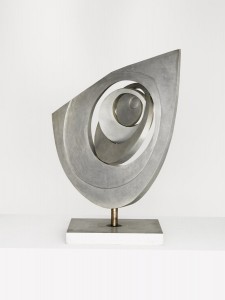Conservation
When treating artworks by deceased artists, whether from the Renaissance or the 20th century, judgment calls must be made by conservators and curators as to the original intention of the artist and the original appearance of the artwork. Physical damage obviously needs attention, but situations such as treating bronzes where the patina is lost through weathering and time require careful consideration; the artist may have wanted a brilliant shine, but contemporary taste may dictate that a distressed appearance better reflects the age of the piece.

Mobile Form, 1973. This is one of Frömel’s pieces with a rotating mechanism, which can be prone to corrosion.
Many of the sculptures included in Gerda Frömel: A Retrospective came from private collections and thus brought about the need for a programme of conservation to enable the works to be displayed. Most pieces simply required cleaning and waxing, but greater interventions were needed in some instances, as the sculptures were made between forty and fifty years ago and, consequently, were starting to show their age. Ireland’s weather and relative humidity, for example, took its toll on several of Frömel’s sculptures, particularly the larger rotating items featured in IMMA’s exhibition, which incorporate a hidden revolving mechanism prone to corrosion.
At the studio in Woodtown, Dublin where Frömel herself once worked, artist and sculpture conservator Jason Ellis, with the assistance of Frömel’s son Killian Schürmann, carefully and thoughtfully worked to restore Frömel’s sculptures to their initial splendor, ensuring that visitors to IMMA’s exhibition would view these skillfully executed sculptures and see, as closely as possible, Frömel’s original intentions.







